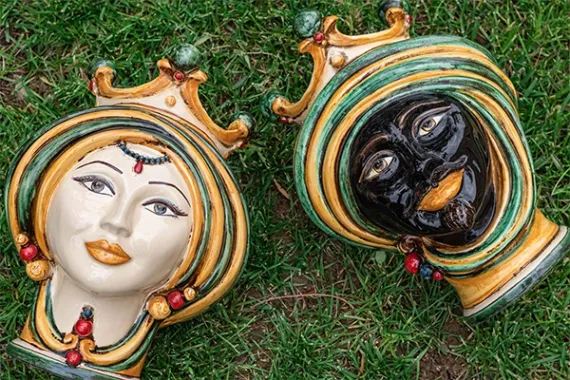Moorheads: an important artistic treasure for the whole of Sicily
Caltagirone Moorheads are one of the most famous and deeply rooted traditions of the Sicilian city of Caltagirone, located in the province of Catania. They are handcrafted ceramic decorations that are used to adorn the facades of houses
These head-shaped vases were first made in the 18th century, but they have been so successful that they are still one of Caltagirone's most important tourist attractions today. Indeed, they represent a true icon of the city, so much so that they have become its symbol.
Sicilian Moors are made of ceramics and are decorated in bright, garish colors, making them unique and particularly eye-catching. They are handmade by local artisans, who use ancient techniques passed down from generation to generation. Each Moorhead is therefore a unique and unrepeatable piece, representing the art and tradition of the city of Caltagirone.
Caltagirone heads are highly valued by both tourists and residents of the city, who use them to decorate their homes. They are in fact an element of great symbolic and cultural value, representing the history and traditions of the city of Caltagirone and an important artistic treasure for the whole of Sicily.
The Caltagirone Moorheads are an element of great historical, artistic, and cultural importance to the Sicilian city of Caltagirone, representing one of its most famous and deeply rooted traditions.



The History of the Moorhead
So widespread in Sicily that they have become one of the island's representative symbols.
It is said that in Palermo, around the year 1100 during the period of Moorish rule in Sicily at the Kalsa, in the beautiful Arab quarter 'Al Hâlisah, where the sultan once stayed, there lived in a palace a beautiful maiden who loved to spend her days tending the flowers and plants on her balcony.
One day passing through the Kalsa a young Moor, saw the beautiful girl, intent on tending the plants, became enamored of her, decided he wanted her for himself, without delay entered the girl's house and declared his love for her. The Maiden, struck by so much feeling, reciprocated the love of the young man who had no qualms about indulging in the sweetest amorous profusions; but the young man, in his heart, concealed a burdensome secret: Wife and children awaited him in the East, in that land to which he was now to return.
The Maiden embittered by that betrayed love, was seized by a baleful wrath that drove her inexorably to take the path of vengeance. She waited for darkness and as soon as it fell asleep she killed it; the Moor thus, who had loved her and was about to depart, would now never leave her again. The maiden also decided that the face of that young man, dear to her and yet dear to her, should remain by her side forever, so without hesitation she cut off the young man's head, creating a vase-like object with it, and placed a basil sprout inside.
The choice of planting basil in it was sanctioned by the fact that, as she well knew, this fragrant plant (from the Greek "Basileus - King"), has always been accompanied by an aura of sacredness, representing in fact the herb of sovereigns; thus, despite the terrible act she had done, she pursued the foolish loving purpose of continuing to care for her beloved.
She finally laid her head on her balcony, devoting each day to caring for the basil that grew in it. Every day the young woman's tears bathed the regal plant, which grew becoming more and more florid and lush.
The neighbors, pervaded by the scent of the basil and looking enviously at the plant maturing in that particular pot in the shape of a Moor's Head, had terracotta pots made that reproduced the same features as the one lovingly guarded by the maiden.
Today, every Moor's Head that is produced bears a crown, an ever-present element aimed at re-proposing the regal plant that originally embellished the head of the young Moor protagonist of the sad affair.